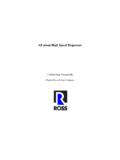Transcription of A Collins S-Line Troubleshooting and Repair …
1 A Collins S-Line Troubleshooting and Repair Adventure Gary White W5GW In October 2011 I obtained a Collins S-Line station from a friend and fellow ham in San Antonio (K5 JWK Gary). It was a winged emblem 32S-1 transmitter, 75S-1 receiver, and a 516F-2 power supply. They are early serial number units, so they were likely built over 50+ years ago (probably in 1958-59). While in the USAF, I had the opportunity to operate many collin KWM-2s and S-Line stations, but never owned or worked on any. This was an opportunity I had always wanted to pursue. Gary let me take them for a few days to inspect them before I committed to the purchase.
2 A very nice offer on his part and it only took me a few hours to decide I wanted to get these units back on the air and we finalized the sale/purchase. An Adventure Begins Neither the transmitter, receiver, or the power supply was working properly when I got them but they were all marginally functional to some degree or another. They were also very clean from a cosmetic perspective. (note: Gary disclosed all issues and I bought these units knowing some degree of Repair would be required there is no buyer s remorse here nor should any be inferred also it should be noted, Gary had obtained these items from an estate and hadn t made any extensive effort to Repair them some of the problems described later were the result of the owner(s) previous to Gary) The following is a brief summary of the Troubleshooting and repairs necessary to bring this equipment back into operations.
3 Hopefully this will serve as encouragement for others to undertake a similar Repair and/or restoration project. 75S-1 Receiver While the receiver came alive, the S-Meter was not reading anything except on very high power signals (such as the 100 kHz calibrator), the S-Meter was also erratic, and the receiver was somewhat anemic and noisy. I concluded that the Repair of the receiver was going to be minimal. Setting the receiver aside for a bit, I turned my attention to the transmitter and power supply. 32S-1 Transmitter and 516F-2 Power Supply The transmitter would not develop any drive, except on 40 meters, and the output power, in tune, was only 10 Watts or so on 40 meters.
4 Clearly the transmitter and its associated power supply had some issues. After working with the transmitter for a few days trying all the usual things (checking voltages, changing tubes, cleaning switch contacts, etc.) it appeared that someone had attempted to align the transmitter in the past. This was evident by the different height of the slugs in the band switch rack and some different coloring on the threaded stems of these slugs. I broke out my oscilloscope and signal generator and started to go thru the manual s signal tracing procedure that injects calibrated signal levels into each stage to look for proper drive and output power.
5 This confirmed that I could tune the driver and finals and get upwards of 40 Watts on all bands. However, going back to the 455 KHz first IF stage and the 3055 kHz IF I could not get any drive by injecting a signal from my signal generator. This pointed to a bad second mixer. Checking all of the resistances in the second mixer confirmed the operating point of the 2nd mixer should be within a normal operating range. However, the voltages on the 2nd mixer did not agree with the voltages in the manual (low 3055 kHz 2nd IF injection voltage). At this point I broke one of my cardinal Repair rules. I decided to align the 455 KHz and 3055 KHz intermediate frequency (IF) stages in an attempt to get sufficient 2nd mixer injection.
6 It is generally not a good idea to attempt realignment unless absolutely necessary. Both stages appeared to be aligned, however I still was not getting proper injection into the 2nd mixer. On 4 November, in utter frustration, I gave the 3055 KHz IF can (T1) slugs some arbitrary turns while monitoring the 3055 KHz signal at the input to the second mixer (V5). Initially the signal dropped but as I continued turning the slug the signal amplitude increased on the oscilloscope. (Note: there was a false, but minor, peak in the 3055 KHz IF can that someone had evidently found previously and which I also found in my first alignment pass of the IF stages.)
7 I also later identified that this false peak occurs in the 75S-1 receiver (the receiver uses a similar IF scheme as the transmitter, but in the case of the receiver it was on the proper peak). This was a major Ah-Ha! moment since from that point on I was able to complete the alignment properly and get drive and power (up to 50 Watts) on all bands. More on the low power problem later, but here are a few lessons learned: Ensure you have the latest manual manuals can be downloaded for free from the Collins Collector Association (CCA) website: In my case I had been using the original equipment manual.
8 However, a later manual, along with all service bulletins provided better procedures for performing alignment and Troubleshooting . Carefully inspect the radio for modifications and repairs. As part of this visual inspection it was obvious some slug twiddling had been done in the past. This was the nudge that allowed me to break a cardinal rule of Repair ( , something that is broke usually doesn t benefit from a realignment and in fact can serve to mask a bad component making the Repair even more difficult). Mixers are good check points for Troubleshooting a heterodyne circuit I d suggest using a combination of verifying resistor values around the mixer and then ensuring that voltages (both DC and RF injection signals and RF output signals) are proper as a start.
9 (note: In this case it was easy to verify proper resistances, yet the DC and RF voltages (injection and output) were out of agreement with the manual poor output from the mixer plus weak 2nd IF injection pointed to a problem in the IF stages prior to the 2nd mixer) Ask for help. I received a lot of help from the CCA members. Notably pointing me away from my original manual to the latest one posted on the website. Low Power Power Creep Plate Meter Accuracy After getting drive and power on all bands, the three remaining problems in the 32S-1were: 1. a slow rise in transmitter power, 2. only 50 Watts output instead of a nominal 95 120 Watts (band dependent), and 3.
10 Almost 300 ma of indicated plate current to get anywhere close to 50 Watts of output power. This last problem was suspected to be a plate current metering issue, and, while it was an issue I wanted to correct, it was temporarily set aside to troubleshoot the first two problems. Suspecting the choke in the power supply, a substitution was made with a known good 516F-2 power supply from my friend Skip, W5 BMK. That substitution confirmed normal power output could be achieved. Back to the 75S-1 Receiver There were three micro-phonic tubes, a bad S-Meter pot as well as some bad electrolytic and paper capacitors.








